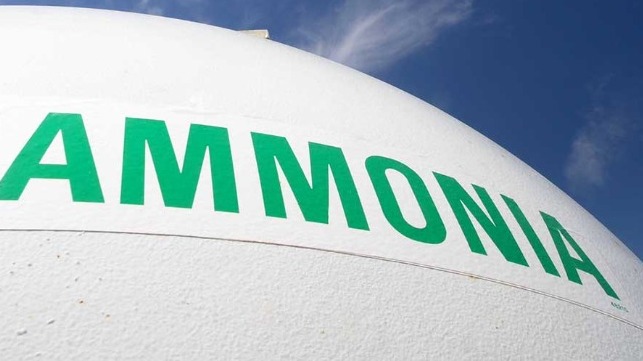Study: Emissions Controls Needed for Ammonia-Fueled Propulsion

Green ammonia is one of the maritime industry's most promising low-carbon fuel alternatives, as it is a high-density means of "storing" green hydrogen on a ship. However, it will have to be used carefully to make sure that the benefits outweigh the harm, according to a careful study prepared by the Maersk McKinney Moller Center for Zero Carbon Shipping. Multiple potential sources of shipboard emissions will have to be addressed in order to meet requirements for health, safety, air quality and GHG emissions.
Ammonia comes with health and safety risks associated with its potential toxicity in the event of a leak, and these hazards are at top of mind in any discussion of its use as a fuel. But it has many other possible challenges related to the ship's exhaust. When burned, ammonia produces NOx and N2O (nitrous oxide). NOx is a well-known and well-regulated air pollutant, and it is associated with public health impacts. N2O is a powerful greenhouse gas, more than 250 times more powerful than CO2. In addition, the combustion process will inevitably release some amount of unburned ammonia into the exhaust stream (ammonia slip).
This means that the exhaust gas from an ammonia-fueled ship will have to be aftertreated to a greater or lesser extent, adding to cost and complexity - and increasing the need for stakeholders and engineers to collaborate in order to get it right, according to the center.
Ammonia slip is the most serious issue on the list, since it is acutely toxic. Acceptable exposure limits vary between research studies, but the highest the center could find was 110 parts per million. The leading class societies have differing standards on acceptable ppm limits, ranging from 25 ppm for everyday release/exhaust up to 350 ppm for automatic safety system activation. The center emphasized that setting the standard very low will reduce risk, but will also increase the size and cost of required aftertreatment systems. In addition, a proliferation of different standards could impede progress.
"A common approach to setting standards is needed to avoid unnecessary uncertainty, and the risk of divergent design and development approaches. The IMO must drive that discussion with the support of industry stakeholders," the center cautioned.
The second challenge is nitrous oxide (N2O). Since it is such a powerful greenhouse gas, even tiny amounts released in the exhaust could quickly outweigh the decarbonization benefits of ammonia propulsion. Hypothetically, an engine that produces one gram of N2O for every 180 grams of ammonia fuel (0.5 percent) would be just as greenhouse gas intensive as a VLSFO-fueled engine.
Minimizing impact will start with engine design and engine tuning. According to the center, engine designers hope to achieve acceptable levels of nitrous oxide and ammonia emissions in the exhaust gas without any aftertreatment. This leaves just the NOx, which would be removed from the exhaust stream using familiar SCR technology.
If this approach is not successful, and the engine produces excessive N2O or ammonia slip, the emissions control system would require multiple steps. A two-step catalytic treatment system is one possibility: an SCR system could handle the NOx, just as in existing modern diesel applications, and could scrub out the N2O as well if properly designed. A separate catalytic process would reduce the amount of ammonia slip in the exhaust stream.
Another, more novel possibility is a newly-developed technology for treating the exhaust gas with plasma, which would control all three pollutants at the same time. However, this approach is still in a developmental stage.
The vessel's fuel tanks, fuel systems, and all ancillary equipment would also require measures to control ammonia emissions. One well-established way to do this is to capture ammonia vapor and send it to a "water catcher" - a tank of freshwater that absorbs the ammonia gas and turns it into a mild ammonia solution. Any gas that is concentrated enough to be flammable could be routed to an auxiliary boiler.
"We believe now is the time for key stakeholders to come together and develop the needed emission management solutions that will mitigate the identified emission risks," concluded the center. "With industry-wide collaboration during engine and emission management technology development and ammonia-fueled vessel design, ammonia emission risks should not be a showstopper for the ammonia-based fuel pathways."
This proactive approach to emissions is a lesson learned from the rollout of LNG as a marine fuel, as "methane slip was not fully understood and addressed upfront" at the time, the center observed.
